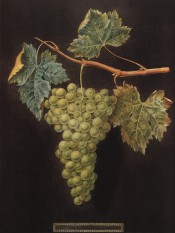Vitis vinifera ‘Muscat Blanc’
‘Bunches rather long, without shoulders. Berries middle-sized, rather closely set, of a muddy white, or greenish yellow, and covered with a thin, white, powdery bloom. Flesh delicate. Juice sugary, very rich, with a highly musky flavour.’ [George Lindley – Orchard Guide p.212/1831].
Horticultural & Botanical History
Figured in Pomona Britannica [PB pl.LIV/1812], the illustration used here.
History at Camden Park
Listed in all printed catalogues as ‘White ditto’ i.e. ‘White Frontignac’ [Vines for Table and for Wine no.17/1843].
In William Macarthur’s words: ‘No. 17 – Muscat Blanc. (White Frontignac, 7/1, 35/1, 307/3, or nos. 7 and 35 of the private collection, and no. 307 of the Montpelier collection [of Busby]). Not so productive apparently as either of the three other varieties of Muscat [Noir, Gris and Rouge], but considered to be preferable for wine, to which it imparts a most delicious perfume; is cultivated at Riversaltes, Lunel, Frontignac, and Constantia, and probably at other vineyards where lucious sweet wines are made. It is also calculated, as are other varieties of the same family, to make highly flavoured dry wines, and for this purpose may be used alone or in combination with other kinds of grape; is also subject to the blight.’ [Maro p.25/1844].
In an advertisement in The Sydney Morning Herald of Saturday 21st of June, 1845 offering vine cuttings for sale, ‘Muscat Blanc’ was described as originating from Lunel, in the Languedoc-Roussillon region, and was priced at 5 shillings per 100.
Notes
Published Jun 23, 2010 - 04:38 PM | Last updated Jul 21, 2011 - 12:30 PM
| Family | Vitaceae |
|---|---|
| Category | |
| Region of origin | Garden origin, probably France |
| Synonyms |
|
| Common Name | Grape, Table Grape, Wine Grape |
| Name in the Camden Park Record |
White ditto i.e. ‘White Frontignac’ |
| Confidence level | high |
